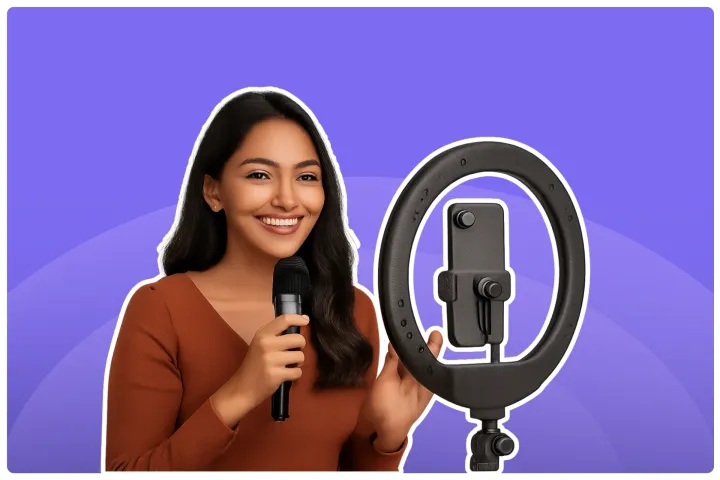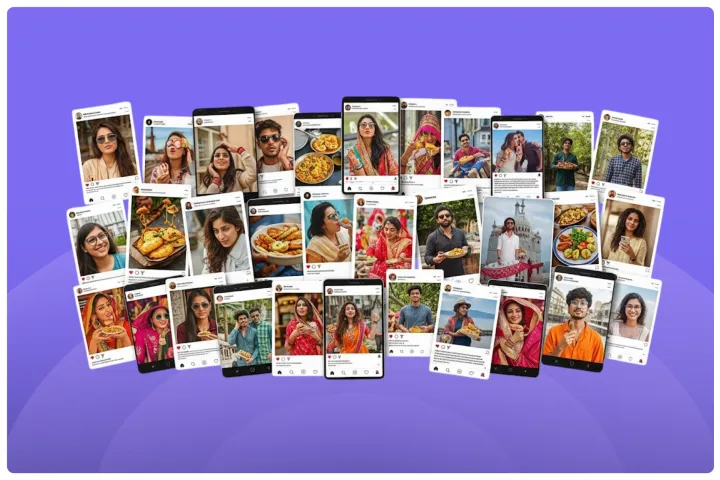How To Post User Generated Content On Instagram
Ready to post user-generated content on Instagram? Explore our tips to engage your followers and create a vibrant community around your brand!
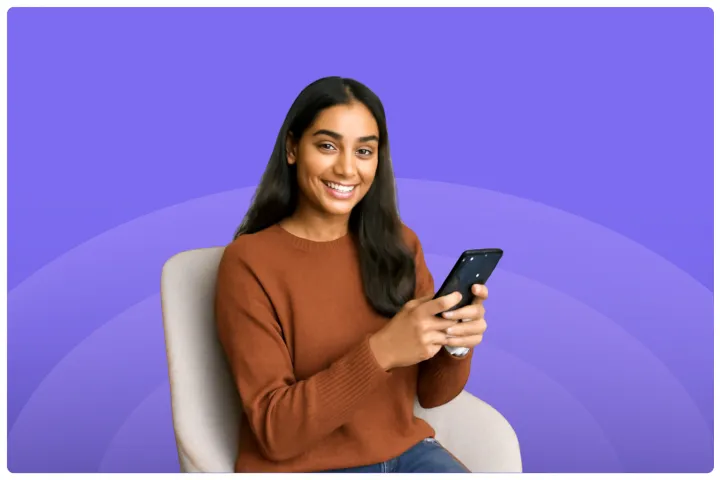
Let's talk about something super exciting for your brand: User-Generated Content, or UGC. If you're looking to make your Instagram pop and really connect with your audience, this is the way to go. We'll break it all down, keep it simple, and show you how to make magic happen.
What Is UGC and Why Should Brands Care?
Alright, first things first. What exactly is this UGC everyone's buzzing about?
Definition: UGC refers to any content—photos, videos, reviews, or testimonials—created by consumers or influencers that showcases your product or service.
Think of it like this: instead of you shouting from the rooftops about how great your brand is, your actual customers are doing it for you! They're sharing their genuine experiences, snaps, and thoughts. This could be a cool photo of them using your product, a video unboxing their latest purchase, a glowing review, or even just a quick story mention. It's content made by the people, for the people.
Now, why should your brand sit up and take notice? Oh, let me count the ways!
Benefits for Brands:
1) Authenticity: Content from real users resonates more with audiences than traditional advertising.
Let's be real, people are smart. They can often spot a polished, corporate ad from a mile away. But when they see someone just like them genuinely loving and using a product? That hits different. It feels real, trustworthy, and relatable.
According to a 2023 Stackla report, 79% of people say UGC highly impacts their purchasing decisions, which is a huge slice of the pie! Another study by Nosto in 2023 revealed that consumers are 2.4 times more likely to say UGC is more authentic compared to brand-created content. This authenticity builds a connection that traditional ads often struggle to achieve. You're not just selling a product; you're showcasing a lifestyle that real people are already enjoying.
2) Cost-Effectiveness: Reduces the need for expensive photoshoots and content creation.
Professional photoshoots, video production, hiring models and locations... it all adds up, right? Especially if you're a growing business, the content creation budget can be a real headache. UGC is your budget-friendly superhero! Your customers become your content creators.
This means a steady stream of fresh, diverse content without the hefty price tag. Imagine having a library of amazing visuals ready to go, all thanks to your awesome community. We're talking about saving thousands, even lakhs, of rupees (₹) here! For instance, a small artisanal coffee brand in Mumbai could save ₹50,000 - ₹1,00,000 on a quarterly lifestyle shoot by instead encouraging customers to share their #MorningCoffeeWith[BrandName] moments.
3) Engagement Boost: Encourages community participation and interaction.
When you share UGC, you're not just posting a picture; you're giving a shout-out to a member of your community. This makes people feel seen, appreciated, and part of something bigger. They're more likely to comment, share, and tag their friends. It sparks conversations and builds a loyal tribe around your brand.
Think about it: if you shared a customer's photo and tagged them, wouldn't they be excited? Wouldn't their friends see it? This ripple effect can significantly increase your reach and engagement. A 2022 Sprout Social report highlighted that user-generated content can lead to significantly higher engagement rates than brand-generated posts. People love seeing themselves and their peers featured!
So, UGC isn't just a nice-to-have; it's a powerful tool for building trust, saving money, and creating a buzzing community around your brand. Pretty cool, huh?
Why Instagram Is the Perfect Platform for UGC
Okay, so we know UGC is awesome. But why is Instagram the MVP (Most Valuable Platform) for it? Well, Instagram and UGC are like chai and biscuits – a perfect match! ☕🍪
1) Visual Appeal: Instagram's image-centric design highlights UGC effectively.
Instagram is all about the visuals. It's a feast for the eyes! Whether it's stunning photos, creative flat lays, or engaging short videos, this platform is designed to make images and videos shine. This is perfect for UGC because customer photos and videos can be incredibly eye-catching. A vibrant photo of a customer wearing your handmade jewellery or a stylish Reel of someone unboxing your latest gadget fits right into the Instagram aesthetic. The platform's focus on high-quality imagery means your customer's cool content gets the spotlight it deserves.
2) High Engagement Rates: Users are more likely to interact with content that feels personal and relatable.
Instagram users are actively looking to connect and engage. They're not just passively scrolling; they're liking, commenting, sharing, and saving posts that resonate with them. And what resonates more than content from real people? As we mentioned earlier, authenticity drives engagement.
When users see content from fellow consumers, it feels less like an ad and more like a recommendation from a friend. This personal touch leads to more likes, comments, and shares. In fact, UGC posts on Instagram can see engagement rates up to 6.9x higher than brand-directed content, according to some 2023 industry observations.
3) Features That Amplify UGC:
Instagram isn't just a pretty face; it has powerful features that are practically made for showcasing UGC.
Reels & Stories: Short-form content formats ideal for showcasing UGC.
Reels: These short, snappy videos are perfect for dynamic UGC. Think customer testimonials, quick product demos by users, unboxing experiences, or even fun challenges. For example, a skincare brand could encourage users to create Reels showing their morning routine using the products, set to trending audio.
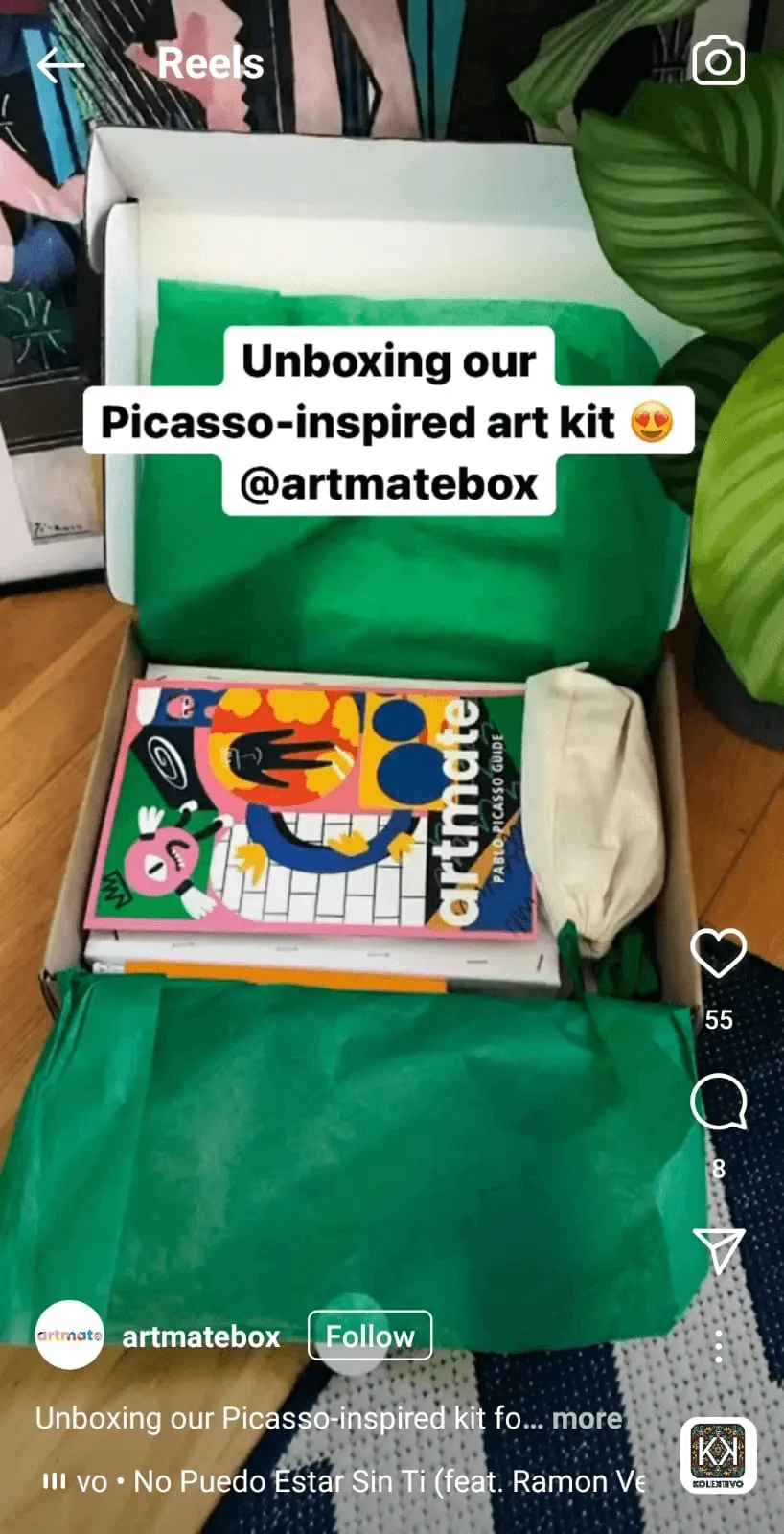
Stories: Instagram Stories are fantastic for more casual, in-the-moment UGC. You can reshare customer mentions, run polls asking users to vote for their favorite UGC pic, or use question stickers to gather testimonials. Stories are also great for "takeovers" where a loyal customer or micro-influencer shares their day using your products. The interactive elements like polls, quizzes, and sliders can further boost engagement with your UGC.

Hashtags: Facilitate content discovery and community building.
Hashtags are your best friends for finding and organizing UGC.
Branded Hashtags: Create a unique hashtag for your brand (e.g., #MyAwesomeBrandStyle, #[YourBrandName]Love) and encourage customers to use it when they post. This creates a dedicated gallery of UGC that you can easily browse.
Campaign Hashtags: Running a specific contest or campaign? Use a unique hashtag for it (e.g., #[YourBrandName]SummerVibes). This helps you track entries and create buzz.
Community Hashtags: Tap into broader community hashtags relevant to your niche (e.g., #IndianFoodBloggers, #SupportSmallBusinessIndia) to increase the visibility of your reposted UGC. When users search for these hashtags or follow them, they can stumble upon your brand through the authentic content shared by your community.
Shoppable Posts: Directly link UGC to product pages, simplifying the purchase journey.
This is where things get really powerful for sales! Instagram's Shoppable Posts feature allows you to tag products directly in your images, including UGC you reshare (with permission, of course!). So, when someone sees a customer looking amazing in your dress or using your cool gadget in a UGC photo on your feed, they can tap the photo, see the product details and price, and click through to buy it directly from your website. It makes the journey from inspiration to purchase super smooth and quick. This turns your UGC from just pretty pictures into direct sales drivers.
Example Screenshot Idea: A lifestyle image on a brand's Instagram feed. A customer is happily using a home decor item. A small shopping bag icon is visible on the item. When tapped, a product tag pops up with the item name and price (e.g., "Bohemian Cushion Cover - ₹899").
Instagram's visual nature, engaged user base, and specialized features make it an unbeatable platform for leveraging the power of UGC. You're not just posting; you're building a vibrant, interactive, and shoppable community.
How To Post User Generated Content On Instagram
Okay, you're convinced. UGC is fantastic, and Instagram is the place to be. But how do you actually do it? How do you get this amazing content and use it effectively? Don't worry, it's simpler than you think! Let's break it down into four key steps: Collecting, Curating, Posting, and Analyzing.
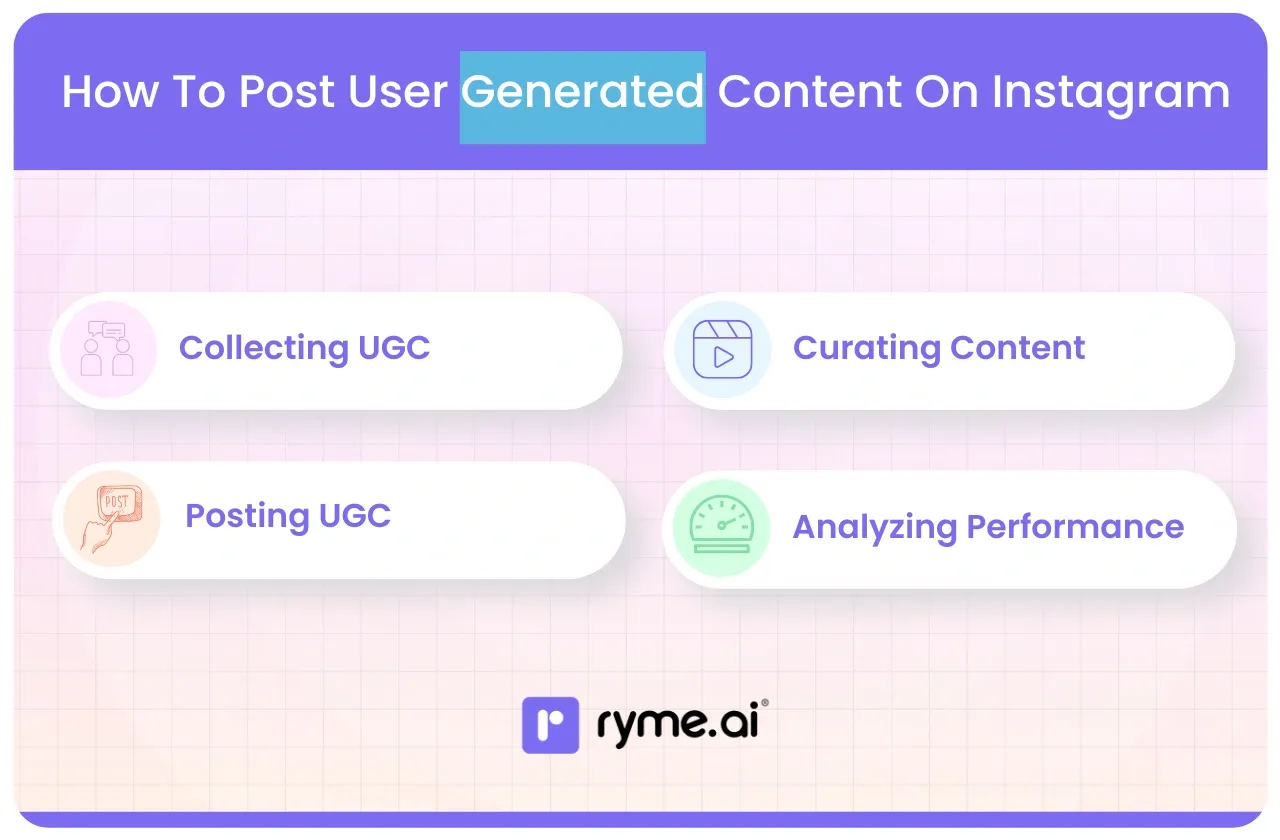
1) Collecting UGC
This is where the fun begins – gathering all that lovely content from your users!
Encourage Submissions: Run campaigns or contests prompting users to share their experiences.
People love a good contest or a chance to be featured!
- Contests: Offer an attractive prize (a product, a voucher like a ₹2000 gift card, a feature on your page) for the best photo or video using your product with a specific branded hashtag. For example, a local bakery could run a "#My[BakeryName]Creation" contest, asking customers to share photos of how they've decorated cakes bought from the bakery.
- Campaigns: Launch a themed campaign. If you sell travel gear, maybe a "#[YourBrandName]Adventures" campaign where users share their travel photos with your products.
- Clear Calls to Action (CTAs): Regularly remind your audience in your posts, Stories, and even your Instagram bio to tag you or use your branded hashtag when they share content featuring your products. Something like: "Love our [product]? Share your snaps with #[YourBrandName] for a chance to be featured!"
Monitor Mentions: Keep an eye on brand mentions and hashtags to discover organic content.
Not everyone will use your official hashtag. People might just tag your account in their photos or Stories, or simply mention your brand name.
- Check Your Tagged Photos: Regularly look at the "Tagged" section on your Instagram profile.
- Monitor Story Mentions: Keep an eye on your notifications for Story mentions. These are time-sensitive, so act fast if you want to reshare!
- Search for Your Brand Name: Occasionally search for your brand name on Instagram to see if any posts pop up that you might have missed.
- Third-party Tools: Some social media management tools can help you track mentions and hashtags more efficiently.
Reach Out: Contact users whose content aligns with your brand for permission to repost.
This is super important! Just because someone tagged you doesn't automatically mean you can use their photo on your feed or in your ads.
- Be Polite and Specific: Send them a friendly Direct Message (DM). Compliment their photo/video and clearly state how you'd like to use their content (e.g., "on our Instagram feed," "in our email newsletter," "on our website").
- Example DM Template: "Hi [User's Name]! 👋 We absolutely LOVE this photo/video of you with our [Product Name]! It's fantastic. Would you mind if we shared it on our Instagram feed and possibly our website? We'll be sure to give you full credit, of course! Let us know. Thanks! 😊"
- Keep Records: Once they give permission, keep a record of it (a screenshot of the DM is fine).
2) Curating Content
You've got a growing pile of potential UGC. Woohoo! Now it's time to pick the best of the best.
Quality Check: Ensure the content aligns with your brand's aesthetic and values.
Not all UGC is created equal. You want content that looks good and fits your brand's image.
- Visual Quality: Is the photo clear, well-lit, and visually appealing? Grainy or blurry photos are usually a no-go.
- Brand Alignment: Does the content reflect your brand's style and message? If your brand is all about minimalism, a very cluttered photo might not be the best fit, even if the product is visible.
- Authenticity: Does it look genuine? Overly edited or staged photos might lose that authentic UGC feel.
- Obtain Rights: Secure explicit permission to use the content in your marketing materials.
We touched on this in the collecting phase, but it's worth repeating because it's crucial, especially if you plan to use the content beyond just a simple Instagram repost (e.g., in paid ads, on your website, in print).
Written Permission: For more extensive use, especially in advertising, getting more formal written permission (even via email exchange) is advisable. Some brands use simple release forms.
Specify Usage: Be clear about where and how long you might use the content. This manages expectations and protects both you and the creator.
Credit Creators: Always tag and acknowledge the original creators to maintain goodwill.
This is non-negotiable! It's their content, after all.
- Tag in Photo/Video: Use Instagram's tagging feature to tag their account directly in the visual.
- Mention in Caption: Mention their handle (e.g., "📸: @[Creator'sHandle]") in your caption. This not only gives them the recognition they deserve but also shows your audience that you value your community. It encourages more people to share content, hoping for a feature!
3) Posting UGC
You've collected and curated some awesome UGC. Now let's get it out there for the world to see!
Optimal Timing: Post during peak engagement hours for your target audience.
You want your UGC posts to get maximum visibility.
- Check Your Instagram Insights: Your Instagram Business/Creator account has analytics that show when your followers are most active. Use this data!
- General Guidelines: While it varies, weekdays during lunchtime (12 PM - 2 PM) and evenings (7 PM - 9 PM) often see good engagement. Experiment and see what works for your audience.
Compelling Captions: Pair UGC with engaging captions that tell a story or highlight product benefits.
Don't just repost the image. Add your own touch!
- Tell the Story: Why did you choose this photo? What do you love about it? Maybe share a bit about the customer (with their permission if it's personal).
- Highlight Benefits: Connect the UGC to your product's value. "Look how @[CustomerHandle] is enjoying a relaxing Sunday with our super-soft throw! Perfect for cozy days in. 🥰"
- Ask Questions: Encourage interaction. "Love this look by @[CustomerHandle]! How would you style our new scarf? Let us know below! 👇"
- Include a Call to Action (CTA): "Inspired by @[CustomerHandle]'s setup? Tap the link in bio to shop the look!"
Hashtags: Use relevant hashtags to increase discoverability.
We talked about hashtags for collecting, but they're just as important for posting.
- Mix it Up: Use a combination of your branded hashtag (e.g., #[YourBrandName]Featured), general relevant hashtags (e.g., #HomeDecorIndia, #FashionDaily), and perhaps some niche or trending ones.
- Don't Overdo It: Instagram allows up to 30, but 5-15 well-chosen hashtags are often more effective. Too many can look spammy.
4) Analyzing Performance
You're posting UGC, which is great! But how do you know if it's actually working? Time to look at the numbers.
Engagement Metrics: Track likes, comments, shares, and saves to gauge audience interest.
These are your primary indicators of how well your UGC is resonating.
- Compare with Brand-Generated Content: Do your UGC posts get more likes or comments than your regular branded posts? This can be very insightful.
- Look for Trends: Which types of UGC get the most engagement? Photos of people using products? Flat lays? Videos?
Conversion Tracking: Monitor how UGC influences website traffic and sales.
Ultimately, you want your marketing efforts to contribute to your bottom line.
- Instagram Shopping Analytics: If you're using shoppable posts with UGC, track how many clicks and sales these posts generate.
- UTM Parameters: When linking to your website from UGC-related posts or Stories (e.g., "Shop this look featured by our customer! Link in bio!"), use UTM parameters in your URLs. This allows you to track in Google Analytics how much traffic and how many conversions are coming from those specific UGC-driven links.
- Promo Codes: You could provide a special promo code in captions of UGC posts or ask customers to mention a certain campaign if they purchase based on seeing UGC.
Feedback Loop: Use insights to refine future UGC campaigns and content strategies.
Analytics aren't just numbers; they're a guide.
- What's Working? If UGC featuring a particular product or style gets tons of engagement, create more opportunities for users to share that kind of content.
- What's Not? If certain types of UGC fall flat, maybe it's not the right fit for your audience, or perhaps the call to action wasn't clear.
- Adjust and Improve: Continuously use these insights to make your UGC strategy even better. Maybe your audience loves seeing 'behind-the-scenes' style UGC from customers. Lean into that!
By following these steps, you'll build a robust UGC machine that not only fills your Instagram feed with authentic, engaging content but also strengthens your community and drives real business results. You got this! 😉
Collaborating with Influencers Using ryme.ai
Now, let's talk about taking your UGC game up a notch by working with influencers. Influencers are essentially power users who have built a dedicated audience that trusts their recommendations. When an influencer creates content featuring your product, it's like supercharged UGC!
But finding the right influencers, managing campaigns, and tracking results can be a bit of a maze, especially if you're juggling a million other things. This is where a platform like ryme.ai can be a game-changer.
ryme.ai is an AI-powered platform designed to simplify influencer marketing and UGC collaboration for brands of all sizes. Think of it as your smart assistant for all things influencer-related. It helps you connect with the right voices and manage your campaigns smoothly.
Key Features:
1) Zero Commission & No Minimum Budget: Make influencer marketing accessible without hidden fees.
This is a big one, especially for small to medium businesses (SMBs) or startups in India. Many traditional agencies or platforms charge hefty commissions or require you to commit to large budgets (think ₹50,000 or ₹1,00,000+ just to get started). ryme.ai often operates on a model that's more transparent and budget-friendly, potentially with subscription tiers or pay-as-you-go options, making it easier for brands with varying budgets to get their foot in the influencer marketing door. This means you can start small, test the waters, and scale as you grow, without worrying about surprise charges eating into your ROI.
2) AI-Powered Influencer Matching: Connect with influencers whose audiences align with your target demographic.
You don't want to just work with any influencer; you want to work with influencers whose followers are your ideal customers. ryme.ai uses artificial intelligence to analyze influencer profiles, content, audience demographics (age, location, interests), engagement rates, and even audience authenticity (weeding out those with fake followers!). So, if you're a sustainable fashion brand targeting eco-conscious millennials in Bangalore, ryme.ai helps you find influencers who genuinely connect with that specific group. This data-driven approach saves you hours of manual searching and increases the chances of your campaign hitting the mark.
3) Real-Time Analytics: Gain insights into campaign performance to optimize strategies.
Once your influencer campaign is live, you need to know how it's doing. Is it driving engagement? Clicks? Sales? ryme.ai typically provides a dashboard where you can track key metrics in real time. This could include reach, impressions, engagement rate on influencer posts, click-through rates on links, and sometimes even conversion data if integrated properly. This allows you to see what's working, what's not, and make quick adjustments to optimize your campaign for better results, rather than waiting until the end and wondering what happened.
4) Streamlined Content Approval: Simplify workflows between brands and influencers, reducing delays.
The back-and-forth between brands and influencers for content approval can be time-consuming. Drafts, feedback, revisions... it can all lead to delays. ryme.ai often includes features to manage this process more efficiently. This might involve a centralized platform where influencers can submit content, brands can provide feedback, and approvals can be tracked. This keeps everything organized, reduces email clutter, and helps get content live faster. Clear communication channels mean fewer misunderstandings and a smoother collaboration.
Benefits for Brands:
Using a platform like ryme.ai brings some fantastic advantages:
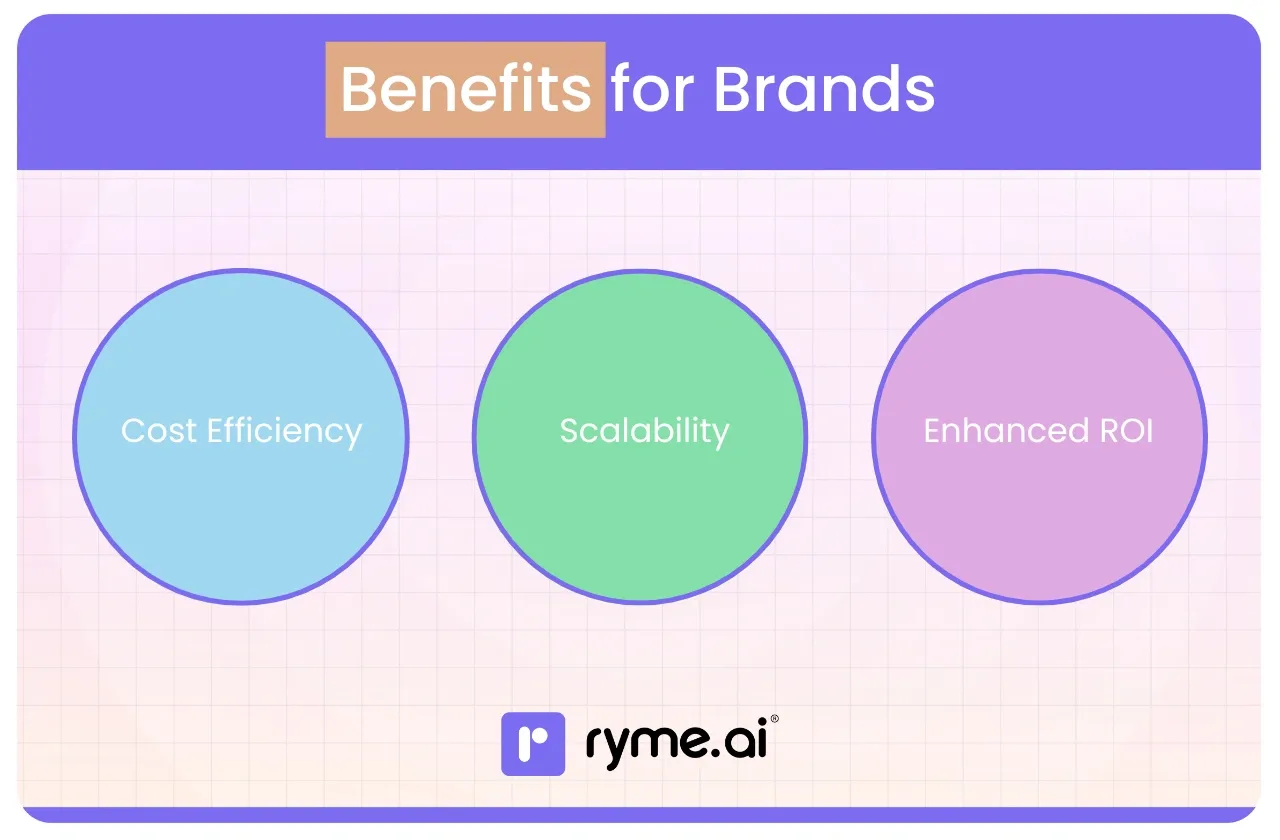
1) Cost Efficiency: Affordable pricing models suitable for small to medium-sized businesses.
Because of features like zero commission and potentially flexible pricing structures, brands (especially SMBs in India who are often budget-conscious) can access powerful influencer marketing tools without breaking the bank. You get more value for your marketing spend (your precious ₹₹₹!). This means you can allocate more of your budget towards actually collaborating with influencers rather than on platform fees.
2) Scalability: Manage multiple campaigns simultaneously with ease.
As your brand grows, you might want to run campaigns with multiple influencers or even run several different campaigns at once. ryme.ai's platform is designed to handle this. With AI matching, streamlined workflows, and centralized analytics, managing a handful or even dozens of influencer collaborations becomes much more manageable than trying to do it all manually through spreadsheets and DMs. You can scale your efforts without scaling your stress levels.
3) Enhanced ROI: Data-driven decisions lead to better resource allocation and improved returns.
This is the bottom line, isn't it? By using AI to find the right influencers and real-time analytics to track performance, you're making smarter, data-backed decisions. You're not just throwing money at influencer marketing and hoping for the best. You're investing strategically, optimizing along the way, and ultimately, getting a better return on your investment.
Better targeting and continuous optimization mean your campaign budget works harder for you, leading to more engagement, more conversions, and a healthier ROI. Research from as recent as 2023 (e.g., from the Influencer Marketing Hub) consistently shows that well-executed influencer marketing yields a strong ROI, often cited as generating ₹500 or more in earned media value for every ₹100 spent. Platforms like ryme.ai aim to help you achieve and exceed such benchmarks.
Using a tool like ryme.ai can demystify influencer marketing and make it a powerful, efficient, and scalable part of your UGC and overall marketing strategy. It's like having an expert guide and a super-efficient assistant all rolled into one!
Best Practices for UGC Campaigns with Influencers
Collaborating with influencers for UGC campaigns can be incredibly rewarding, but like any good partnership, it thrives on clarity, respect, and a bit of fun! Here are some best practices to ensure your campaigns are a hit for everyone involved.
1) Clear Guidelines: Provide influencers with specific instructions to ensure content aligns with brand messaging.
While you want influencers to be authentic, they also need to understand your brand and campaign goals.
- The Creative Brief: This is your holy grail! It should include:
- About Your Brand: Your mission, values, target audience.
- Campaign Objectives: What do you want to achieve? (e.g., brand awareness, product promotion, sign-ups).
- Key Messages: What are the 1-3 main points you want the influencer to convey about your product/service?
- Content Requirements: Number of posts/Stories, format (photo, video, Reel), any specific visuals to include (e.g., product packaging clearly visible).
- Dos and Don'ts: Things to definitely include or avoid (e.g., "Do highlight the eco-friendly packaging," "Don't mention competitors").
- Call to Action: What should the influencer ask their audience to do? (e.g., "Swipe up to shop," "Use my code [INFLUENCERCODE] for 15% off," "Visit @[YourBrandHandle]").
- Hashtags & Mentions: Specify any campaign hashtags and ensure they know to tag your brand.
- Disclosure: Remind them about FTC/ASCI guidelines for disclosing sponsored posts (e.g., using #ad, #sponsored, #partnership). In India, ASCI guidelines are key.
- Keep it Concise: Don't overwhelm them with a 20-page document. Make it clear, actionable, and easy to digest.
- Example: For a new organic tea launch, your brief might ask influencers to create a Reel showing them preparing and enjoying the tea, highlighting its calming benefits and unique flavour, using #OrganicTeaTime and #[YourBrandName]Relax.
2) Creative Freedom: Allow influencers to inject their personality into the content for authenticity.
This might sound contradictory to "clear guidelines," but it's about balance. You chose an influencer for their unique voice and connection with their audience. If you overly script their content, it will come across as inauthentic and won't resonate.
- Trust Their Expertise: They know what their audience likes. Give them the key messages and guidelines, then let them weave those into their own style.
- Encourage Storytelling: Ask them to share a genuine experience or story related to your product. This is far more powerful than just listing features.
- Authenticity is Key: Remember, a primary benefit of influencer UGC is its authenticity. Stifling their creativity can diminish this. Audiences can spot an overly controlled message. A 2023 study by Bazaarvoice noted that 51% of consumers believe it's important for influencers to have creative control over sponsored content to maintain authenticity.
- Example: Instead of telling an influencer exactly what to say, you might say, "We'd love for you to show how our noise-cancelling headphones help you focus while working from home, in your own creative way!"
3) Incentivize Participation: Offer rewards or recognition to encourage more users (not just influencers) to share content.
While influencers are usually compensated (with payment, free products, or both), you can extend the idea of incentives to their audience too!
- Influencer-Specific Contests: Ask the influencer to host a giveaway or contest for their followers, related to your brand. For example, "Comment why you need a @[YourBrandHandle] planner for a chance to win one! Tag a friend who also needs to get organized!" This generates buzz and additional UGC from their audience.
- Exclusive Discount Codes: Provide the influencer with a unique discount code for their followers (e.g., "RIA20" for 20% off). This not only incentivizes purchases but also helps you track sales coming directly from that influencer.
- Feature Follower UGC: Encourage the influencer to ask their followers to create their own UGC using your branded hashtag, with the promise that the brand (you!) might feature some of their followers' posts too. This broadens participation.
- Feature UGC Regularly: Consistently showcase user content (from influencers and everyday customers) to maintain community engagement.
Don't let your UGC efforts be a one-time thing. Make it an ongoing part of your content calendar.
4) Dedicated UGC Slots: Maybe have a "Fan Photo Friday" or a weekly round-up of your favorite customer posts in your Stories.
- Mix It Up: Blend influencer-created UGC with content from your everyday customers. This shows a wide range of real people loving your brand.
- Show Appreciation: Whenever you feature UGC (influencer or customer), give genuine praise and thanks. This encourages continued sharing and makes your community feel valued.
- Longevity: Seeing that you consistently feature UGC makes people more likely to share their own content in the future, hoping for their moment in the spotlight. This creates a self-sustaining cycle of content.
By following these best practices, your influencer UGC campaigns will not only deliver great content but also build stronger relationships with influencers and foster a more engaged community around your brand. It’s all about collaboration and celebrating your customers! 🎉
Measuring the Impact of UGC
So, you're running UGC campaigns, perhaps even with influencers. Your Instagram feed is looking lively and authentic. That's awesome! But how do you really know if all this effort is paying off? You need to measure the impact. Tracking the right metrics will show you what's working, what's not, and how UGC is contributing to your overall business goals. Let's look at the key areas:
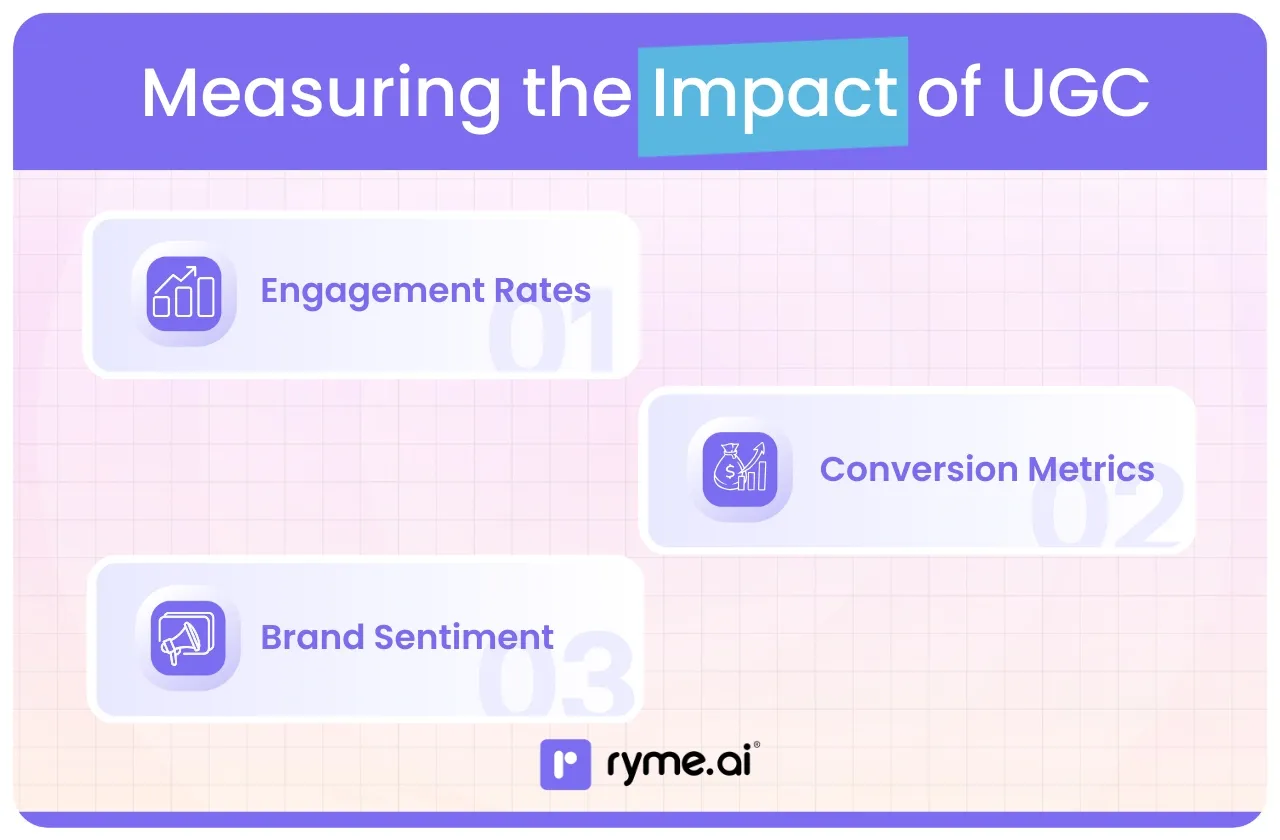
1) Engagement Rates: Monitor interactions to assess audience interest.
Engagement is the most direct way to see if your UGC is resonating with your audience. High engagement means people are actively interacting with the content, which is a great sign!
Key Metrics to Track:
- Likes: The simplest form of appreciation.
- Comments: Indicates a deeper level of engagement and conversation. Are people asking questions? Tagging friends? Sharing positive feedback?
- Shares: Shows that people find the content valuable enough to share with their own networks, extending your reach.
- Saves: This is a strong indicator! People save posts they want to come back to, which often means they find it useful, inspiring, or are considering a purchase.
How to Track:
- Instagram Insights: For posts on your own feed (including reposted UGC), your Instagram Insights will provide all these metrics per post.
- Influencer Reports: If working with influencers, they should provide you with the performance metrics of their posts featuring your brand. Platforms like ryme.ai can automate this.
What to Look For:
- Compare engagement on UGC posts versus your regular brand-created content. Often, UGC performs better due to its authenticity. According to a 2023 Sprout Social Index, consumer engagement often increases with UGC.
- Identify which types of UGC (e.g., customer photos, influencer videos, unboxing Reels) get the highest engagement. This helps you tailor future UGC requests.
2) Conversion Metrics: Track sales and website visits originating from UGC posts.
Engagement is great, but for most businesses, the ultimate goal is to drive sales and grow the business. So, you need to see if your UGC efforts are turning viewers into customers.
Key Metrics to Track:
- Website Clicks/Traffic: How many people are clicking the links in your bio or on shoppable UGC posts to visit your website?
- Product Page Views: For shoppable posts, how many views are your tagged products getting?
- Sales/Conversions: The big one! How many purchases, sign-ups, or other desired actions are directly attributable to your UGC initiatives?
How to Track:
- Instagram Shopping Insights: If you use Instagram Shopping to tag products in UGC, it will provide data on product page views and, if your checkout is integrated, sometimes sales.
- UTM Parameters: This is crucial. When you use a link in your bio or an influencer shares a link in their Stories or bio, make sure that link has UTM parameters. These are little tags you add to your URL that tell Google Analytics (or other analytics software) where the traffic came from (e.g., yourwebsite.com/product?utm_source=instagram&utm_medium=ugc_post&utm_campaign=summer_style). This allows you to see in your website analytics exactly how many visits, and more importantly, how many conversions (like sales) came from specific UGC posts or influencer campaigns.
- Unique Discount Codes: Assign unique discount codes to different UGC campaigns or influencers (e.g., "SUMMERUGC15" or "INFLUENCERNAME10"). When these codes are used at checkout, you can directly attribute sales to that specific UGC source.
- Calculating ROI: By tracking revenue generated from UGC campaigns and comparing it to your investment (e.g., cost of products gifted, influencer fees, platform costs if using ryme.ai), you can calculate your Return on Investment.
3) Brand Sentiment: Analyze comments and feedback to gauge public perception.
Beyond numbers, UGC also gives you valuable qualitative insights into how people feel about your brand.
What to Look For:
- Positive Comments: Are people expressing love for your products, sharing positive experiences, or complimenting your brand?
- Questions: What kind of questions are people asking in response to UGC? This can reveal areas where you need to provide more information or highlight certain benefits.
- Tone of Conversation: Is the overall sentiment positive, neutral, or negative?
How to Track:
- Manual Monitoring: Regularly read through the comments on your UGC posts and on influencer posts featuring your brand.
- Social Listening Tools: For larger brands, social listening tools can automatically track mentions of your brand across social media and analyze the sentiment of those mentions. Some influencer platforms might also offer sentiment analysis features.
- Why It Matters: Positive brand sentiment builds trust and loyalty. If you see negative sentiment or recurring concerns, it's an opportunity to address issues, improve your products/services, or clarify misunderstandings. For instance, a 2022 Edelman Trust Barometer report emphasized that trust is more important than ever for brands, and authentic UGC often contributes to this.
By consistently tracking these three areas – Engagement, Conversions, and Brand Sentiment – you'll get a holistic view of your UGC's impact. These insights are gold! They help you prove the value of your UGC strategy, make data-driven decisions to optimize your campaigns, and ultimately, build a stronger, more profitable brand. Keep measuring, keep learning, and keep growing! 📈
Conclusion
User-Generated Content (UGC) is powerful for Instagram because it provides authenticity, saves marketing costs, and boosts engagement. Consumers trust UGC more than ads. Instagram's visual focus and features amplify these benefits, turning customer love into content and sales. Collaborating with influencers via platforms like ryme.ai streamlines the process.
Successful UGC involves clear communication, incentivizing participation, and measuring impact. UGC is a conversation with customers, building a relatable and trustworthy brand. Encourage customers to share their content and watch your community grow.
Actionable Checklist & Key Takeaways:
Here’s a quick rundown to get you started or to supercharge your existing UGC strategy:
✅ Define Your UGC Goals: What do you want to achieve? (Brand awareness, engagement, sales?)
✅ Create a Branded Hashtag: Make it unique and easy to remember (e.g., #[YourBrandName]Moments). Promote it everywhere!
✅ Actively Encourage Submissions:
- Run a contest or giveaway (e.g., "Share a pic with #My[Brand]Style to win a ₹1000 voucher!").
- Put clear calls-to-action in your bio, posts, and Stories.
✅ Monitor Mentions & Hashtags Regularly: Don't miss out on organic UGC.
✅ Always Ask for Permission Before Reposting: Send a friendly DM and explain how you'll use the content.
✅ Curate for Quality & Brand Fit: Choose UGC that aligns with your brand’s aesthetic and values.
✅ ALWAYS Credit the Original Creator: Tag them in the photo/video and mention them in the caption.
✅ Write Engaging Captions for Reposted UGC: Tell a story, ask a question, add value.
✅ Use Instagram's Features Wisely:
- Showcase UGC in Reels and Stories.
- Make UGC shoppable with product tags.
✅ Explore Influencer Collaboration (Consider ryme.ai):
- Find influencers whose audience matches yours.
- Provide clear briefs but allow creative freedom.
✅ Track Your Performance:
- Monitor engagement (likes, comments, shares, saves).
- Track conversions (website clicks, sales using UTMs or promo codes).
- Gauge brand sentiment through comments.
✅ Be Consistent: Make UGC a regular part of your content strategy.
✅ Engage with Your Community: Respond to comments on UGC posts and thank users for sharing.
